University Accounting Report: Financial Analysis and Planning
VerifiedAdded on 2021/04/21
|18
|2930
|422
Report
AI Summary
This comprehensive report, prepared for a Master of Professional Accounting program, delves into various financial accounting concepts and their practical applications. It begins by calculating the annual deposit amount required for university expenses, considering interest rates and the number of years. The report then evaluates different banks for investment, comparing future values and recommending the most viable option. It further explores the time value of money, analyzing the impact of early investments on retirement savings and comparing the financial outcomes of different investment strategies. The report also assesses the profitability and performance of Telstra and TPG, comparing key financial metrics like operating profit margin, return on assets, and return on equity, along with stock prices and sales figures to determine the better-performing company. Additionally, the report discusses compounding and discounting, crucial financial factors for investment evaluation, and emphasizes the importance of retirement planning, including asset allocation and the impact of interest rates. Finally, the report investigates the effects of cash rates on the Australian tourism sector, analyzing historical data and the reasons behind changes in cash rates, to understand the impact of monetary policy on the industry. The report concludes with a discussion on the implications of cash rate changes and their impact on economic indicators.
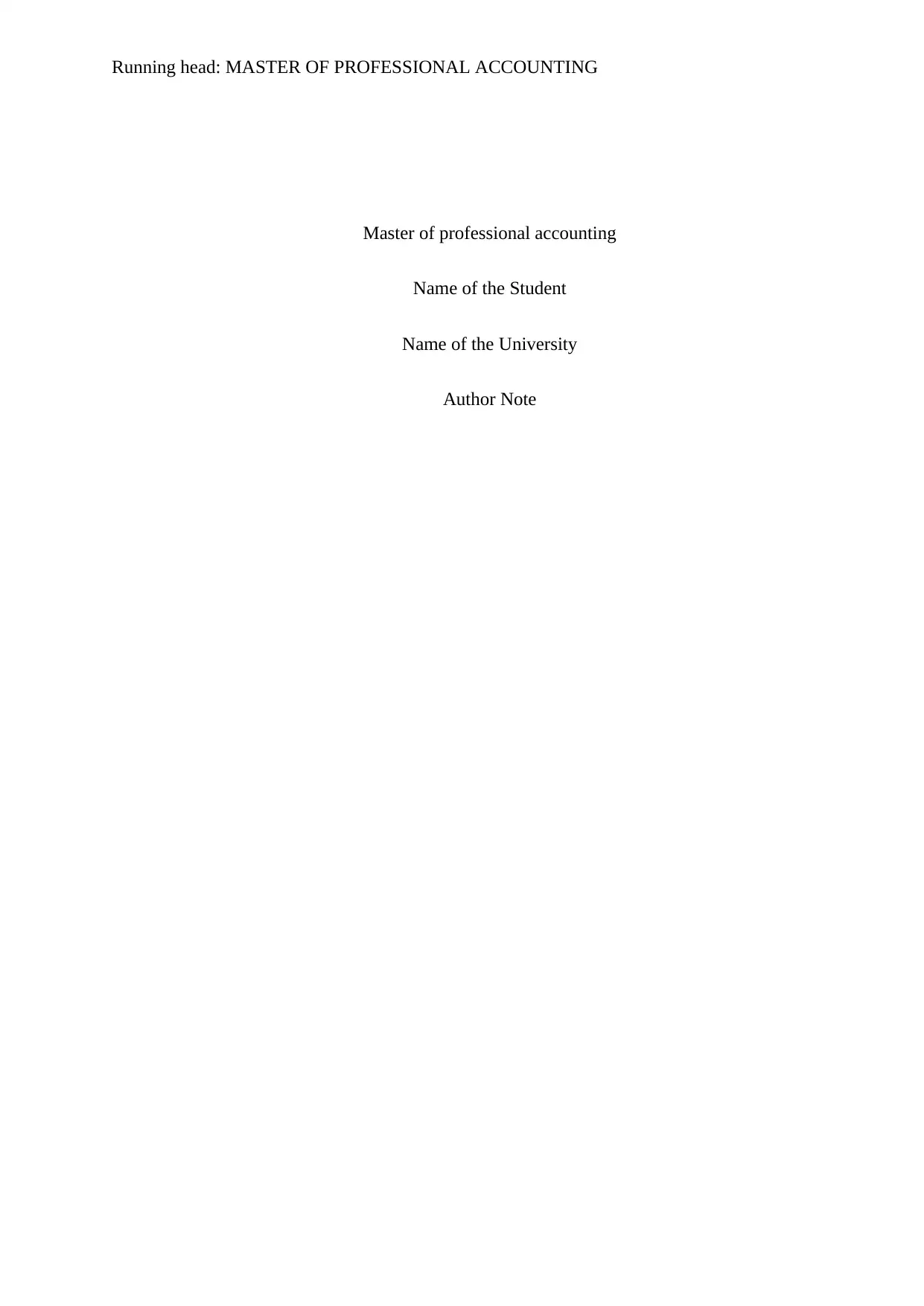
Running head: MASTER OF PROFESSIONAL ACCOUNTING
Master of professional accounting
Name of the Student
Name of the University
Author Note
Master of professional accounting
Name of the Student
Name of the University
Author Note
Paraphrase This Document
Need a fresh take? Get an instant paraphrase of this document with our AI Paraphraser
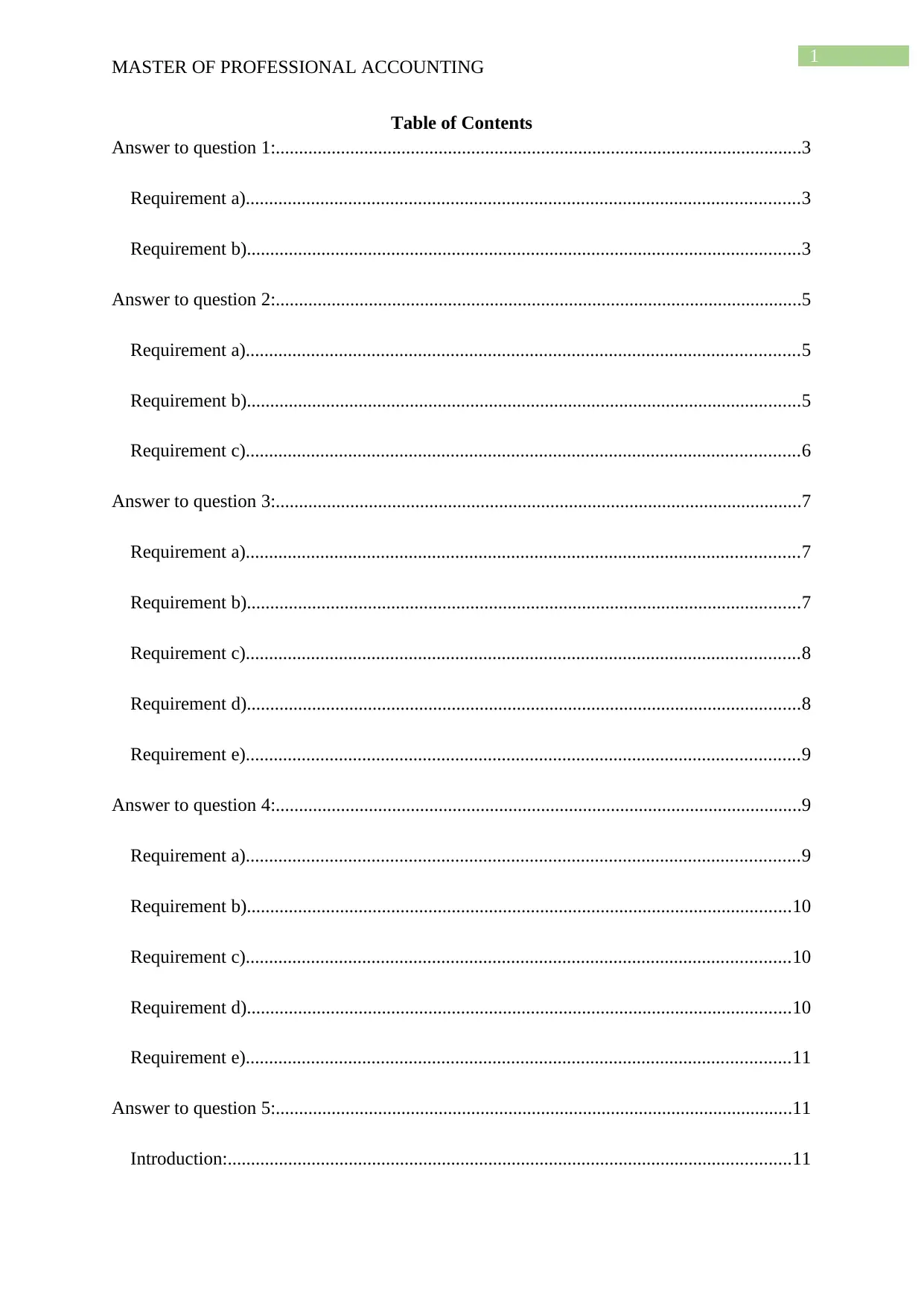
1
MASTER OF PROFESSIONAL ACCOUNTING
Table of Contents
Answer to question 1:.................................................................................................................3
Requirement a).......................................................................................................................3
Requirement b).......................................................................................................................3
Answer to question 2:.................................................................................................................5
Requirement a).......................................................................................................................5
Requirement b).......................................................................................................................5
Requirement c).......................................................................................................................6
Answer to question 3:.................................................................................................................7
Requirement a).......................................................................................................................7
Requirement b).......................................................................................................................7
Requirement c).......................................................................................................................8
Requirement d).......................................................................................................................8
Requirement e).......................................................................................................................9
Answer to question 4:.................................................................................................................9
Requirement a).......................................................................................................................9
Requirement b).....................................................................................................................10
Requirement c).....................................................................................................................10
Requirement d).....................................................................................................................10
Requirement e).....................................................................................................................11
Answer to question 5:...............................................................................................................11
Introduction:.........................................................................................................................11
MASTER OF PROFESSIONAL ACCOUNTING
Table of Contents
Answer to question 1:.................................................................................................................3
Requirement a).......................................................................................................................3
Requirement b).......................................................................................................................3
Answer to question 2:.................................................................................................................5
Requirement a).......................................................................................................................5
Requirement b).......................................................................................................................5
Requirement c).......................................................................................................................6
Answer to question 3:.................................................................................................................7
Requirement a).......................................................................................................................7
Requirement b).......................................................................................................................7
Requirement c).......................................................................................................................8
Requirement d).......................................................................................................................8
Requirement e).......................................................................................................................9
Answer to question 4:.................................................................................................................9
Requirement a).......................................................................................................................9
Requirement b).....................................................................................................................10
Requirement c).....................................................................................................................10
Requirement d).....................................................................................................................10
Requirement e).....................................................................................................................11
Answer to question 5:...............................................................................................................11
Introduction:.........................................................................................................................11
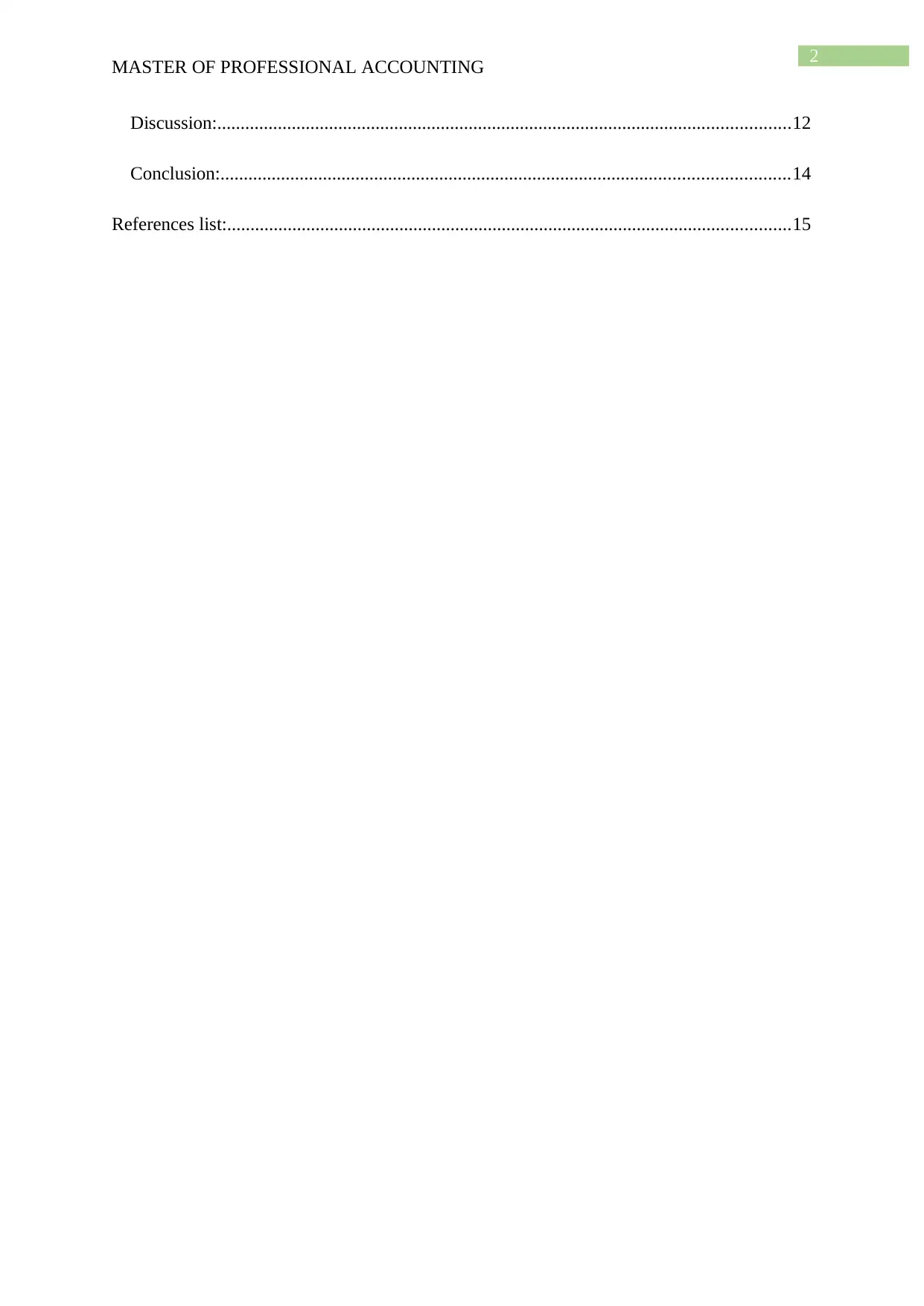
2
MASTER OF PROFESSIONAL ACCOUNTING
Discussion:...........................................................................................................................12
Conclusion:..........................................................................................................................14
References list:.........................................................................................................................15
MASTER OF PROFESSIONAL ACCOUNTING
Discussion:...........................................................................................................................12
Conclusion:..........................................................................................................................14
References list:.........................................................................................................................15
⊘ This is a preview!⊘
Do you want full access?
Subscribe today to unlock all pages.

Trusted by 1+ million students worldwide
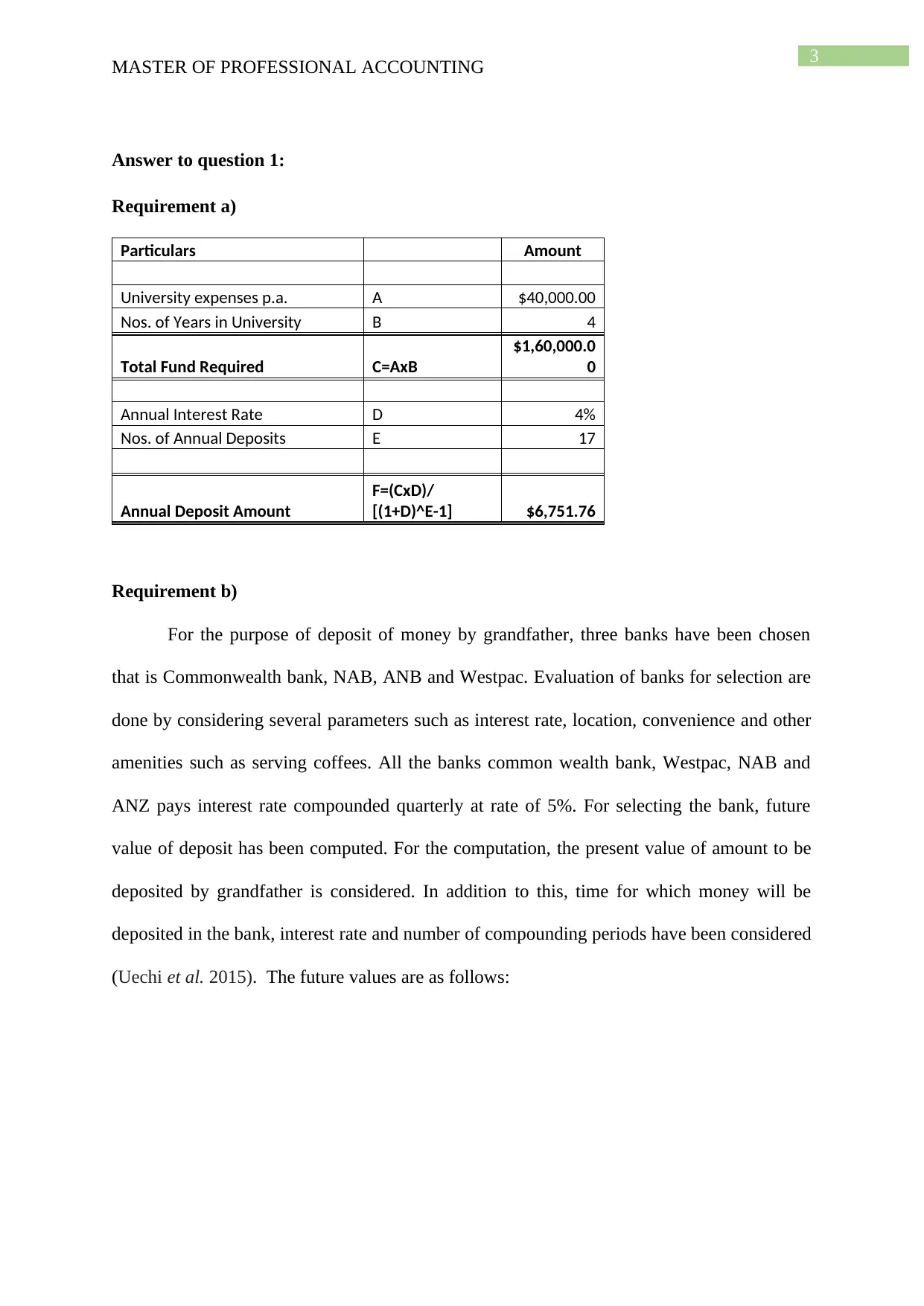
3
MASTER OF PROFESSIONAL ACCOUNTING
Answer to question 1:
Requirement a)
Particulars Amount
University expenses p.a. A $40,000.00
Nos. of Years in University B 4
Total Fund Required C=AxB
$1,60,000.0
0
Annual Interest Rate D 4%
Nos. of Annual Deposits E 17
Annual Deposit Amount
F=(CxD)/
[(1+D)^E-1] $6,751.76
Requirement b)
For the purpose of deposit of money by grandfather, three banks have been chosen
that is Commonwealth bank, NAB, ANB and Westpac. Evaluation of banks for selection are
done by considering several parameters such as interest rate, location, convenience and other
amenities such as serving coffees. All the banks common wealth bank, Westpac, NAB and
ANZ pays interest rate compounded quarterly at rate of 5%. For selecting the bank, future
value of deposit has been computed. For the computation, the present value of amount to be
deposited by grandfather is considered. In addition to this, time for which money will be
deposited in the bank, interest rate and number of compounding periods have been considered
(Uechi et al. 2015). The future values are as follows:
MASTER OF PROFESSIONAL ACCOUNTING
Answer to question 1:
Requirement a)
Particulars Amount
University expenses p.a. A $40,000.00
Nos. of Years in University B 4
Total Fund Required C=AxB
$1,60,000.0
0
Annual Interest Rate D 4%
Nos. of Annual Deposits E 17
Annual Deposit Amount
F=(CxD)/
[(1+D)^E-1] $6,751.76
Requirement b)
For the purpose of deposit of money by grandfather, three banks have been chosen
that is Commonwealth bank, NAB, ANB and Westpac. Evaluation of banks for selection are
done by considering several parameters such as interest rate, location, convenience and other
amenities such as serving coffees. All the banks common wealth bank, Westpac, NAB and
ANZ pays interest rate compounded quarterly at rate of 5%. For selecting the bank, future
value of deposit has been computed. For the computation, the present value of amount to be
deposited by grandfather is considered. In addition to this, time for which money will be
deposited in the bank, interest rate and number of compounding periods have been considered
(Uechi et al. 2015). The future values are as follows:
Paraphrase This Document
Need a fresh take? Get an instant paraphrase of this document with our AI Paraphraser
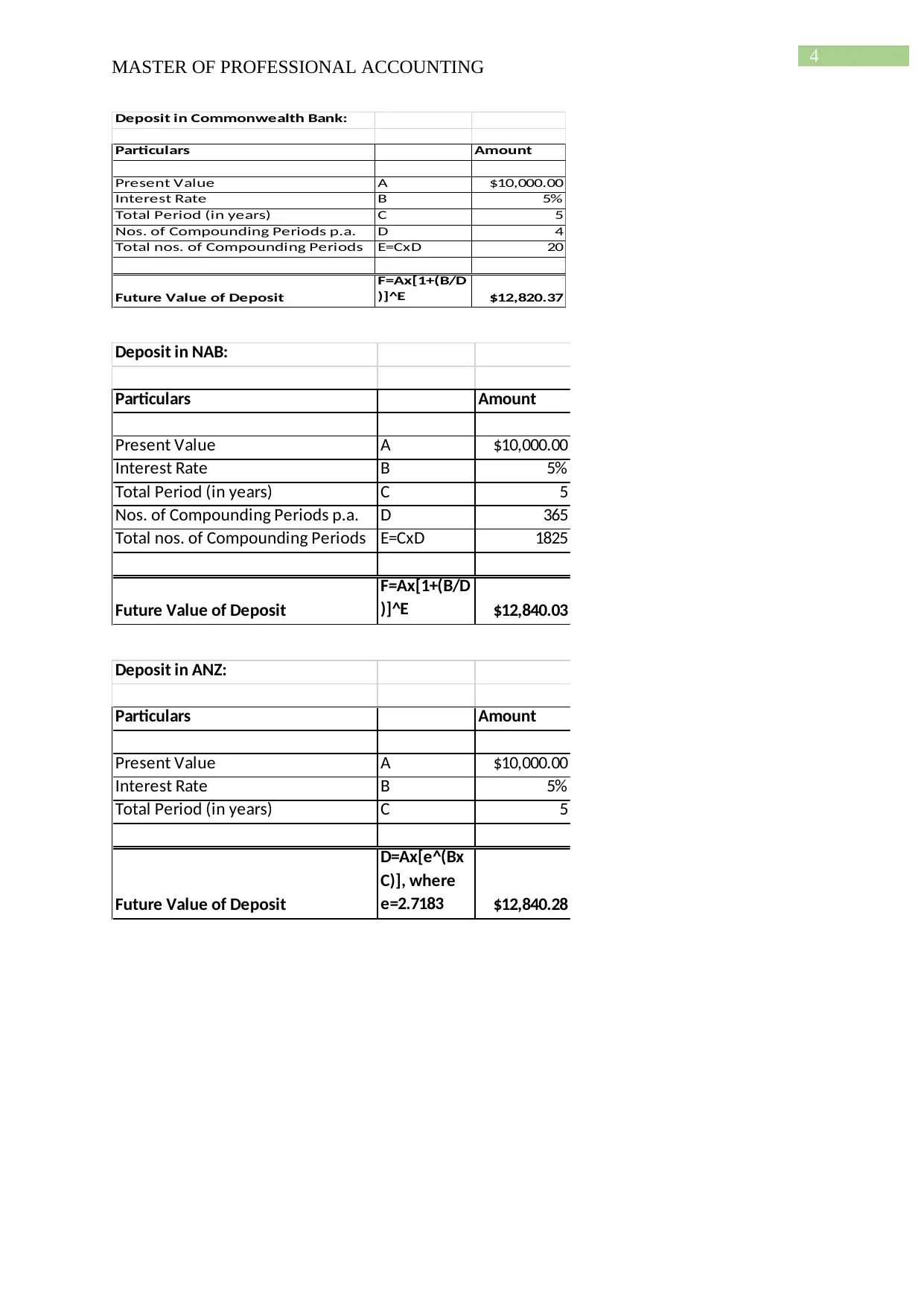
4
MASTER OF PROFESSIONAL ACCOUNTING
Deposit in Commonwealth Bank:
Particulars Amount
Present Value A $10,000.00
Interest Rate B 5%
Total Period (in years) C 5
Nos. of Compounding Periods p.a. D 4
Total nos. of Compounding Periods E=CxD 20
Future Value of Deposit
F=Ax[1+(B/D
)]^E $12,820.37
Deposit in NAB:
Particulars Amount
Present Value A $10,000.00
Interest Rate B 5%
Total Period (in years) C 5
Nos. of Compounding Periods p.a. D 365
Total nos. of Compounding Periods E=CxD 1825
Future Value of Deposit
F=Ax[1+(B/D
)]^E $12,840.03
Deposit in ANZ:
Particulars Amount
Present Value A $10,000.00
Interest Rate B 5%
Total Period (in years) C 5
Future Value of Deposit
D=Ax[e^(Bx
C)], where
e=2.7183 $12,840.28
MASTER OF PROFESSIONAL ACCOUNTING
Deposit in Commonwealth Bank:
Particulars Amount
Present Value A $10,000.00
Interest Rate B 5%
Total Period (in years) C 5
Nos. of Compounding Periods p.a. D 4
Total nos. of Compounding Periods E=CxD 20
Future Value of Deposit
F=Ax[1+(B/D
)]^E $12,820.37
Deposit in NAB:
Particulars Amount
Present Value A $10,000.00
Interest Rate B 5%
Total Period (in years) C 5
Nos. of Compounding Periods p.a. D 365
Total nos. of Compounding Periods E=CxD 1825
Future Value of Deposit
F=Ax[1+(B/D
)]^E $12,840.03
Deposit in ANZ:
Particulars Amount
Present Value A $10,000.00
Interest Rate B 5%
Total Period (in years) C 5
Future Value of Deposit
D=Ax[e^(Bx
C)], where
e=2.7183 $12,840.28
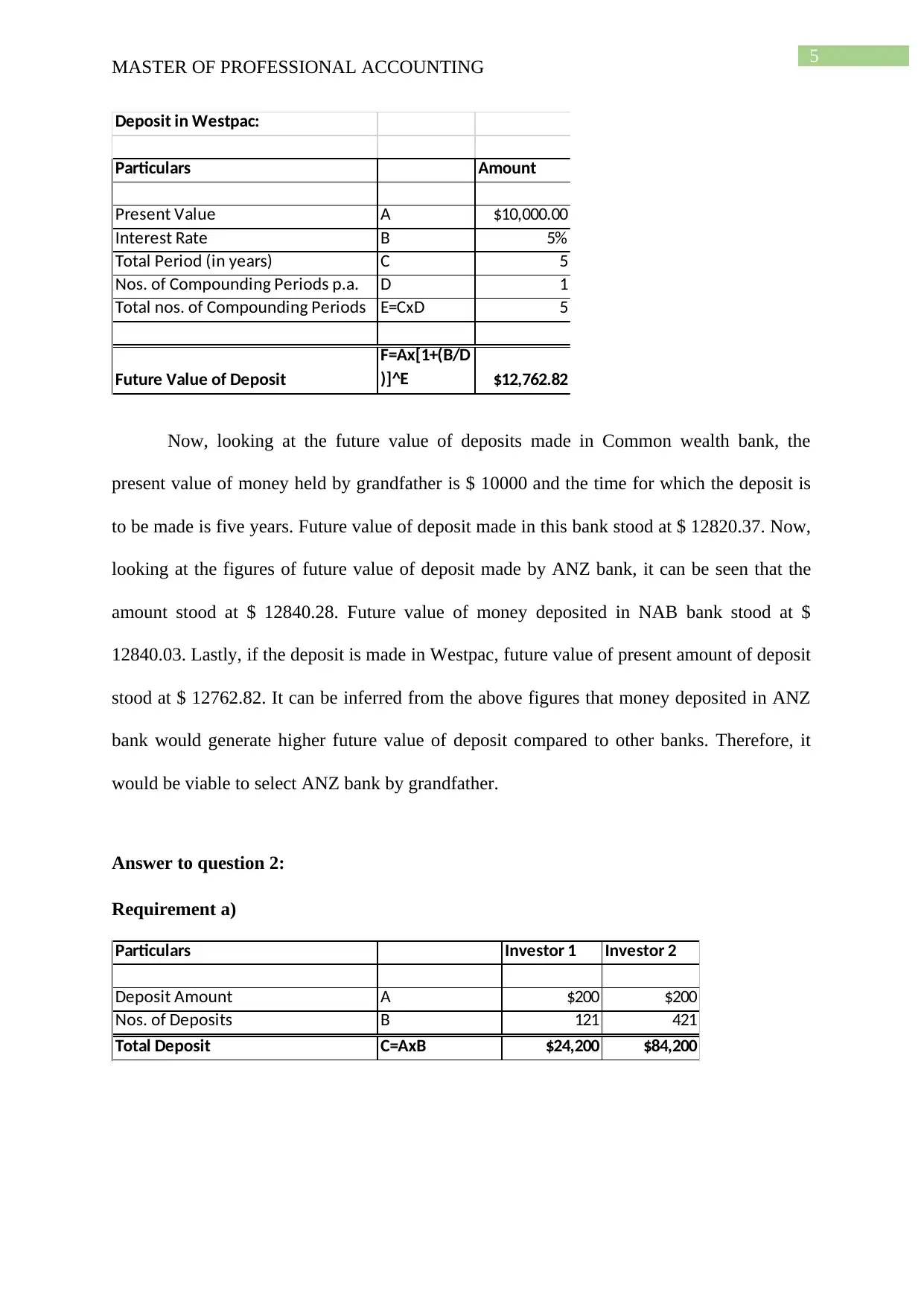
5
MASTER OF PROFESSIONAL ACCOUNTING
Deposit in Westpac:
Particulars Amount
Present Value A $10,000.00
Interest Rate B 5%
Total Period (in years) C 5
Nos. of Compounding Periods p.a. D 1
Total nos. of Compounding Periods E=CxD 5
Future Value of Deposit
F=Ax[1+(B/D
)]^E $12,762.82
Now, looking at the future value of deposits made in Common wealth bank, the
present value of money held by grandfather is $ 10000 and the time for which the deposit is
to be made is five years. Future value of deposit made in this bank stood at $ 12820.37. Now,
looking at the figures of future value of deposit made by ANZ bank, it can be seen that the
amount stood at $ 12840.28. Future value of money deposited in NAB bank stood at $
12840.03. Lastly, if the deposit is made in Westpac, future value of present amount of deposit
stood at $ 12762.82. It can be inferred from the above figures that money deposited in ANZ
bank would generate higher future value of deposit compared to other banks. Therefore, it
would be viable to select ANZ bank by grandfather.
Answer to question 2:
Requirement a)
Particulars Investor 1 Investor 2
Deposit Amount A $200 $200
Nos. of Deposits B 121 421
Total Deposit C=AxB $24,200 $84,200
MASTER OF PROFESSIONAL ACCOUNTING
Deposit in Westpac:
Particulars Amount
Present Value A $10,000.00
Interest Rate B 5%
Total Period (in years) C 5
Nos. of Compounding Periods p.a. D 1
Total nos. of Compounding Periods E=CxD 5
Future Value of Deposit
F=Ax[1+(B/D
)]^E $12,762.82
Now, looking at the future value of deposits made in Common wealth bank, the
present value of money held by grandfather is $ 10000 and the time for which the deposit is
to be made is five years. Future value of deposit made in this bank stood at $ 12820.37. Now,
looking at the figures of future value of deposit made by ANZ bank, it can be seen that the
amount stood at $ 12840.28. Future value of money deposited in NAB bank stood at $
12840.03. Lastly, if the deposit is made in Westpac, future value of present amount of deposit
stood at $ 12762.82. It can be inferred from the above figures that money deposited in ANZ
bank would generate higher future value of deposit compared to other banks. Therefore, it
would be viable to select ANZ bank by grandfather.
Answer to question 2:
Requirement a)
Particulars Investor 1 Investor 2
Deposit Amount A $200 $200
Nos. of Deposits B 121 421
Total Deposit C=AxB $24,200 $84,200
⊘ This is a preview!⊘
Do you want full access?
Subscribe today to unlock all pages.

Trusted by 1+ million students worldwide
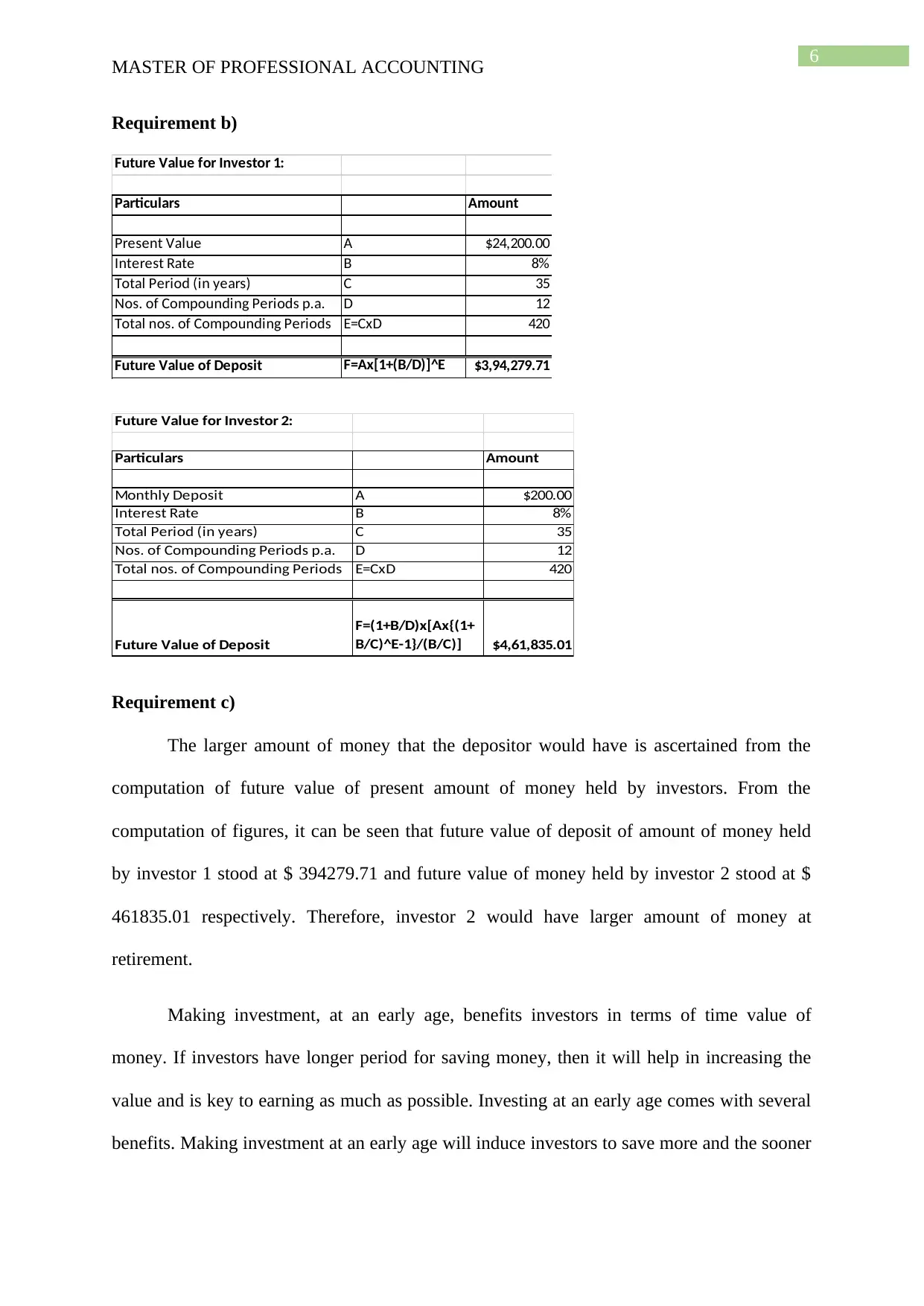
6
MASTER OF PROFESSIONAL ACCOUNTING
Requirement b)
Future Value for Investor 1:
Particulars Amount
Present Value A $24,200.00
Interest Rate B 8%
Total Period (in years) C 35
Nos. of Compounding Periods p.a. D 12
Total nos. of Compounding Periods E=CxD 420
Future Value of Deposit F=Ax[1+(B/D)]^E $3,94,279.71
Future Value for Investor 2:
Particulars Amount
Monthly Deposit A $200.00
Interest Rate B 8%
Total Period (in years) C 35
Nos. of Compounding Periods p.a. D 12
Total nos. of Compounding Periods E=CxD 420
Future Value of Deposit
F=(1+B/D)x[Ax{(1+
B/C)^E-1}/(B/C)] $4,61,835.01
Requirement c)
The larger amount of money that the depositor would have is ascertained from the
computation of future value of present amount of money held by investors. From the
computation of figures, it can be seen that future value of deposit of amount of money held
by investor 1 stood at $ 394279.71 and future value of money held by investor 2 stood at $
461835.01 respectively. Therefore, investor 2 would have larger amount of money at
retirement.
Making investment, at an early age, benefits investors in terms of time value of
money. If investors have longer period for saving money, then it will help in increasing the
value and is key to earning as much as possible. Investing at an early age comes with several
benefits. Making investment at an early age will induce investors to save more and the sooner
MASTER OF PROFESSIONAL ACCOUNTING
Requirement b)
Future Value for Investor 1:
Particulars Amount
Present Value A $24,200.00
Interest Rate B 8%
Total Period (in years) C 35
Nos. of Compounding Periods p.a. D 12
Total nos. of Compounding Periods E=CxD 420
Future Value of Deposit F=Ax[1+(B/D)]^E $3,94,279.71
Future Value for Investor 2:
Particulars Amount
Monthly Deposit A $200.00
Interest Rate B 8%
Total Period (in years) C 35
Nos. of Compounding Periods p.a. D 12
Total nos. of Compounding Periods E=CxD 420
Future Value of Deposit
F=(1+B/D)x[Ax{(1+
B/C)^E-1}/(B/C)] $4,61,835.01
Requirement c)
The larger amount of money that the depositor would have is ascertained from the
computation of future value of present amount of money held by investors. From the
computation of figures, it can be seen that future value of deposit of amount of money held
by investor 1 stood at $ 394279.71 and future value of money held by investor 2 stood at $
461835.01 respectively. Therefore, investor 2 would have larger amount of money at
retirement.
Making investment, at an early age, benefits investors in terms of time value of
money. If investors have longer period for saving money, then it will help in increasing the
value and is key to earning as much as possible. Investing at an early age comes with several
benefits. Making investment at an early age will induce investors to save more and the sooner
Paraphrase This Document
Need a fresh take? Get an instant paraphrase of this document with our AI Paraphraser
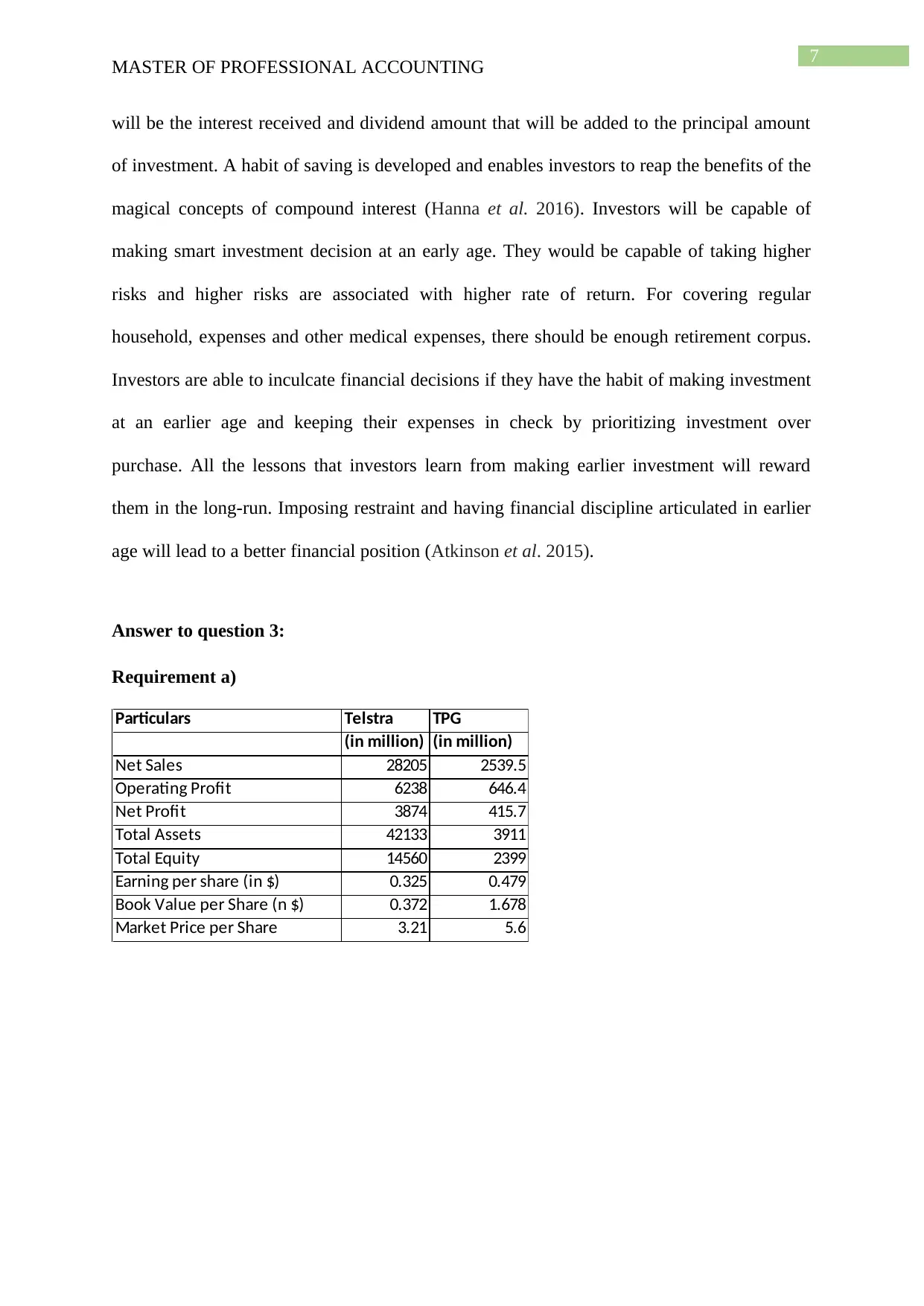
7
MASTER OF PROFESSIONAL ACCOUNTING
will be the interest received and dividend amount that will be added to the principal amount
of investment. A habit of saving is developed and enables investors to reap the benefits of the
magical concepts of compound interest (Hanna et al. 2016). Investors will be capable of
making smart investment decision at an early age. They would be capable of taking higher
risks and higher risks are associated with higher rate of return. For covering regular
household, expenses and other medical expenses, there should be enough retirement corpus.
Investors are able to inculcate financial decisions if they have the habit of making investment
at an earlier age and keeping their expenses in check by prioritizing investment over
purchase. All the lessons that investors learn from making earlier investment will reward
them in the long-run. Imposing restraint and having financial discipline articulated in earlier
age will lead to a better financial position (Atkinson et al. 2015).
Answer to question 3:
Requirement a)
Particulars Telstra TPG
(in million) (in million)
Net Sales 28205 2539.5
Operating Profit 6238 646.4
Net Profit 3874 415.7
Total Assets 42133 3911
Total Equity 14560 2399
Earning per share (in $) 0.325 0.479
Book Value per Share (n $) 0.372 1.678
Market Price per Share 3.21 5.6
MASTER OF PROFESSIONAL ACCOUNTING
will be the interest received and dividend amount that will be added to the principal amount
of investment. A habit of saving is developed and enables investors to reap the benefits of the
magical concepts of compound interest (Hanna et al. 2016). Investors will be capable of
making smart investment decision at an early age. They would be capable of taking higher
risks and higher risks are associated with higher rate of return. For covering regular
household, expenses and other medical expenses, there should be enough retirement corpus.
Investors are able to inculcate financial decisions if they have the habit of making investment
at an earlier age and keeping their expenses in check by prioritizing investment over
purchase. All the lessons that investors learn from making earlier investment will reward
them in the long-run. Imposing restraint and having financial discipline articulated in earlier
age will lead to a better financial position (Atkinson et al. 2015).
Answer to question 3:
Requirement a)
Particulars Telstra TPG
(in million) (in million)
Net Sales 28205 2539.5
Operating Profit 6238 646.4
Net Profit 3874 415.7
Total Assets 42133 3911
Total Equity 14560 2399
Earning per share (in $) 0.325 0.479
Book Value per Share (n $) 0.372 1.678
Market Price per Share 3.21 5.6
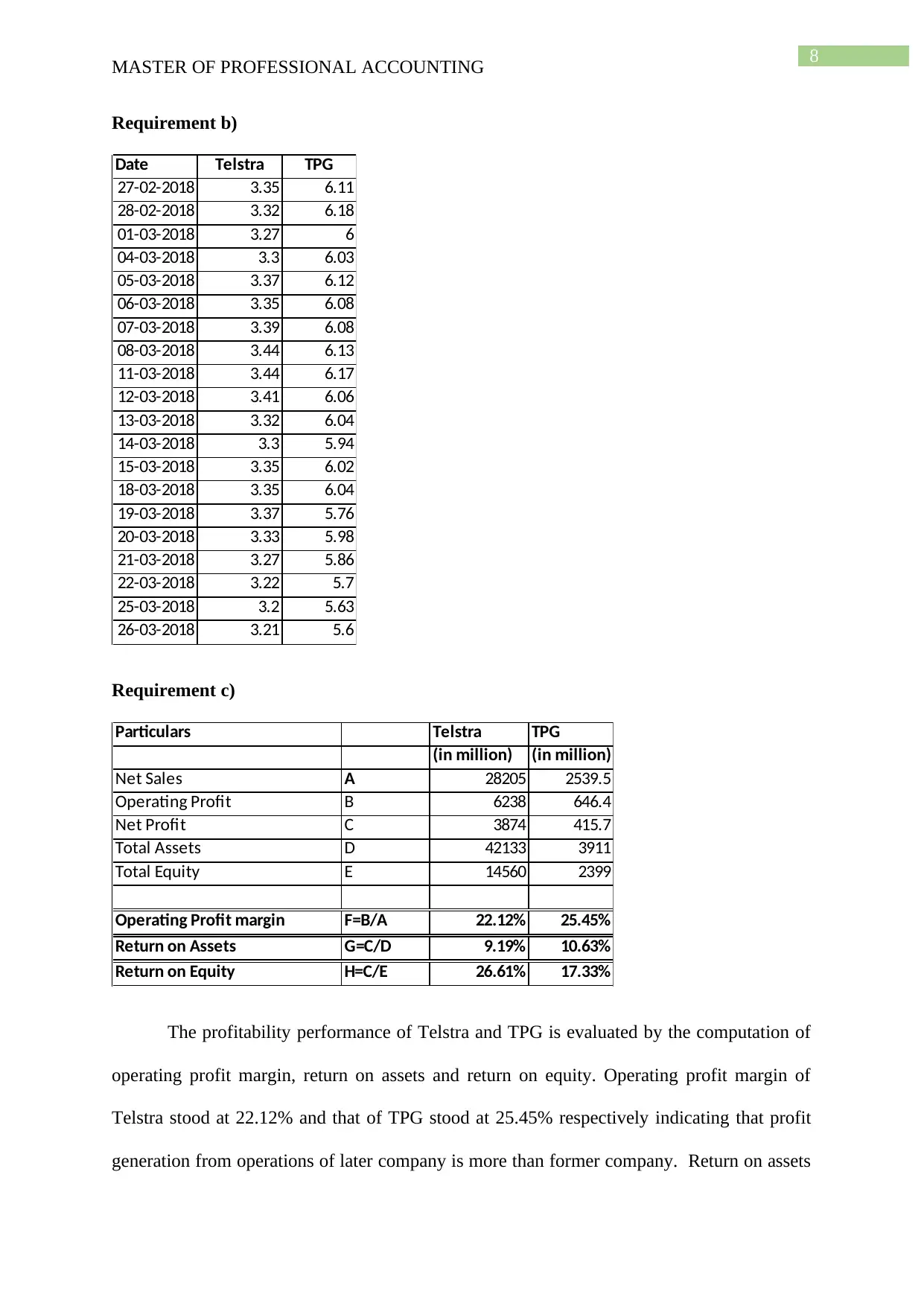
8
MASTER OF PROFESSIONAL ACCOUNTING
Requirement b)
Date Telstra TPG
27-02-2018 3.35 6.11
28-02-2018 3.32 6.18
01-03-2018 3.27 6
04-03-2018 3.3 6.03
05-03-2018 3.37 6.12
06-03-2018 3.35 6.08
07-03-2018 3.39 6.08
08-03-2018 3.44 6.13
11-03-2018 3.44 6.17
12-03-2018 3.41 6.06
13-03-2018 3.32 6.04
14-03-2018 3.3 5.94
15-03-2018 3.35 6.02
18-03-2018 3.35 6.04
19-03-2018 3.37 5.76
20-03-2018 3.33 5.98
21-03-2018 3.27 5.86
22-03-2018 3.22 5.7
25-03-2018 3.2 5.63
26-03-2018 3.21 5.6
Requirement c)
Particulars Telstra TPG
(in million) (in million)
Net Sales A 28205 2539.5
Operating Profit B 6238 646.4
Net Profit C 3874 415.7
Total Assets D 42133 3911
Total Equity E 14560 2399
Operating Profit margin F=B/A 22.12% 25.45%
Return on Assets G=C/D 9.19% 10.63%
Return on Equity H=C/E 26.61% 17.33%
The profitability performance of Telstra and TPG is evaluated by the computation of
operating profit margin, return on assets and return on equity. Operating profit margin of
Telstra stood at 22.12% and that of TPG stood at 25.45% respectively indicating that profit
generation from operations of later company is more than former company. Return on assets
MASTER OF PROFESSIONAL ACCOUNTING
Requirement b)
Date Telstra TPG
27-02-2018 3.35 6.11
28-02-2018 3.32 6.18
01-03-2018 3.27 6
04-03-2018 3.3 6.03
05-03-2018 3.37 6.12
06-03-2018 3.35 6.08
07-03-2018 3.39 6.08
08-03-2018 3.44 6.13
11-03-2018 3.44 6.17
12-03-2018 3.41 6.06
13-03-2018 3.32 6.04
14-03-2018 3.3 5.94
15-03-2018 3.35 6.02
18-03-2018 3.35 6.04
19-03-2018 3.37 5.76
20-03-2018 3.33 5.98
21-03-2018 3.27 5.86
22-03-2018 3.22 5.7
25-03-2018 3.2 5.63
26-03-2018 3.21 5.6
Requirement c)
Particulars Telstra TPG
(in million) (in million)
Net Sales A 28205 2539.5
Operating Profit B 6238 646.4
Net Profit C 3874 415.7
Total Assets D 42133 3911
Total Equity E 14560 2399
Operating Profit margin F=B/A 22.12% 25.45%
Return on Assets G=C/D 9.19% 10.63%
Return on Equity H=C/E 26.61% 17.33%
The profitability performance of Telstra and TPG is evaluated by the computation of
operating profit margin, return on assets and return on equity. Operating profit margin of
Telstra stood at 22.12% and that of TPG stood at 25.45% respectively indicating that profit
generation from operations of later company is more than former company. Return on assets
⊘ This is a preview!⊘
Do you want full access?
Subscribe today to unlock all pages.

Trusted by 1+ million students worldwide
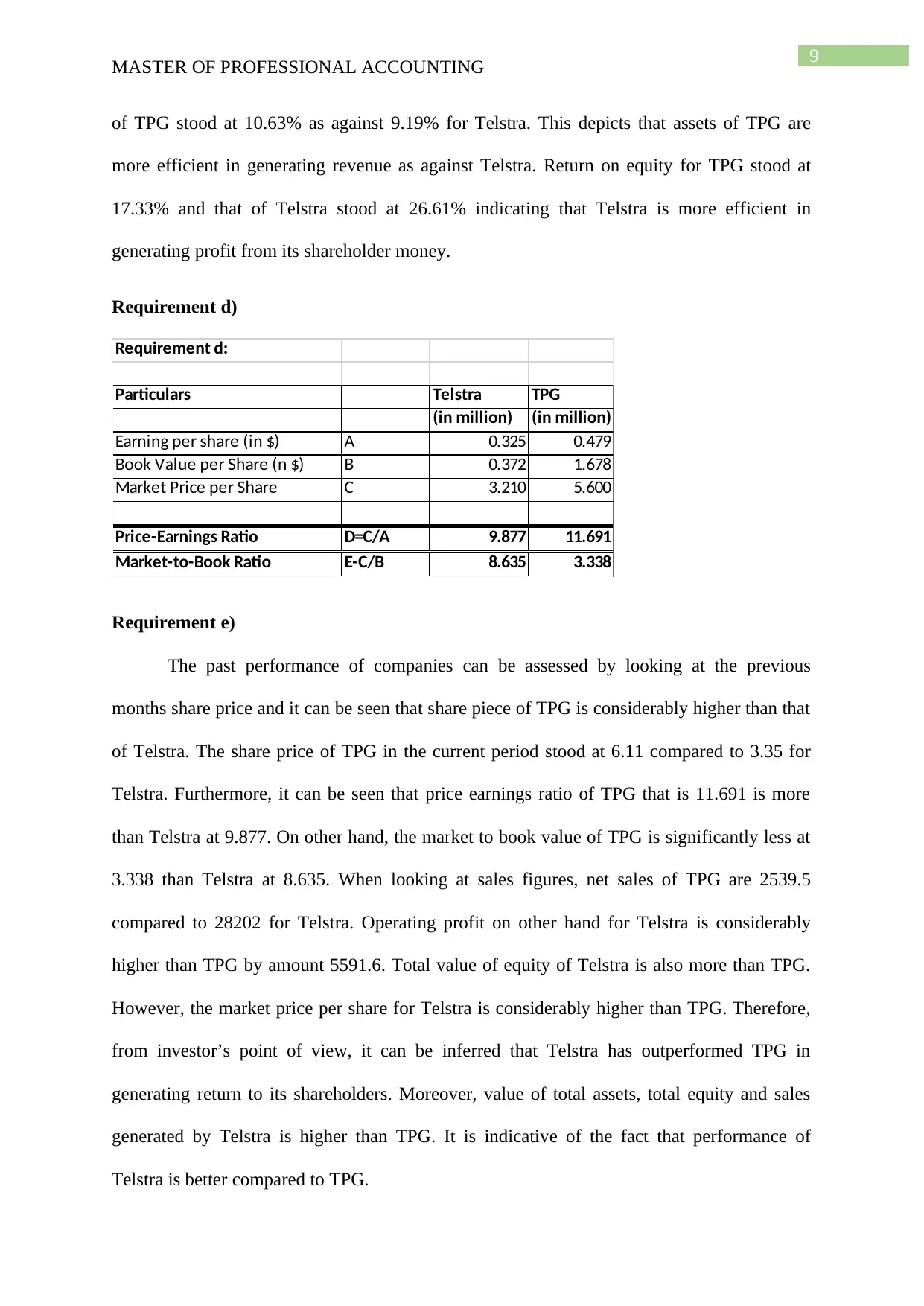
9
MASTER OF PROFESSIONAL ACCOUNTING
of TPG stood at 10.63% as against 9.19% for Telstra. This depicts that assets of TPG are
more efficient in generating revenue as against Telstra. Return on equity for TPG stood at
17.33% and that of Telstra stood at 26.61% indicating that Telstra is more efficient in
generating profit from its shareholder money.
Requirement d)
Requirement d:
Particulars Telstra TPG
(in million) (in million)
Earning per share (in $) A 0.325 0.479
Book Value per Share (n $) B 0.372 1.678
Market Price per Share C 3.210 5.600
Price-Earnings Ratio D=C/A 9.877 11.691
Market-to-Book Ratio E-C/B 8.635 3.338
Requirement e)
The past performance of companies can be assessed by looking at the previous
months share price and it can be seen that share piece of TPG is considerably higher than that
of Telstra. The share price of TPG in the current period stood at 6.11 compared to 3.35 for
Telstra. Furthermore, it can be seen that price earnings ratio of TPG that is 11.691 is more
than Telstra at 9.877. On other hand, the market to book value of TPG is significantly less at
3.338 than Telstra at 8.635. When looking at sales figures, net sales of TPG are 2539.5
compared to 28202 for Telstra. Operating profit on other hand for Telstra is considerably
higher than TPG by amount 5591.6. Total value of equity of Telstra is also more than TPG.
However, the market price per share for Telstra is considerably higher than TPG. Therefore,
from investor’s point of view, it can be inferred that Telstra has outperformed TPG in
generating return to its shareholders. Moreover, value of total assets, total equity and sales
generated by Telstra is higher than TPG. It is indicative of the fact that performance of
Telstra is better compared to TPG.
MASTER OF PROFESSIONAL ACCOUNTING
of TPG stood at 10.63% as against 9.19% for Telstra. This depicts that assets of TPG are
more efficient in generating revenue as against Telstra. Return on equity for TPG stood at
17.33% and that of Telstra stood at 26.61% indicating that Telstra is more efficient in
generating profit from its shareholder money.
Requirement d)
Requirement d:
Particulars Telstra TPG
(in million) (in million)
Earning per share (in $) A 0.325 0.479
Book Value per Share (n $) B 0.372 1.678
Market Price per Share C 3.210 5.600
Price-Earnings Ratio D=C/A 9.877 11.691
Market-to-Book Ratio E-C/B 8.635 3.338
Requirement e)
The past performance of companies can be assessed by looking at the previous
months share price and it can be seen that share piece of TPG is considerably higher than that
of Telstra. The share price of TPG in the current period stood at 6.11 compared to 3.35 for
Telstra. Furthermore, it can be seen that price earnings ratio of TPG that is 11.691 is more
than Telstra at 9.877. On other hand, the market to book value of TPG is significantly less at
3.338 than Telstra at 8.635. When looking at sales figures, net sales of TPG are 2539.5
compared to 28202 for Telstra. Operating profit on other hand for Telstra is considerably
higher than TPG by amount 5591.6. Total value of equity of Telstra is also more than TPG.
However, the market price per share for Telstra is considerably higher than TPG. Therefore,
from investor’s point of view, it can be inferred that Telstra has outperformed TPG in
generating return to its shareholders. Moreover, value of total assets, total equity and sales
generated by Telstra is higher than TPG. It is indicative of the fact that performance of
Telstra is better compared to TPG.
Paraphrase This Document
Need a fresh take? Get an instant paraphrase of this document with our AI Paraphraser
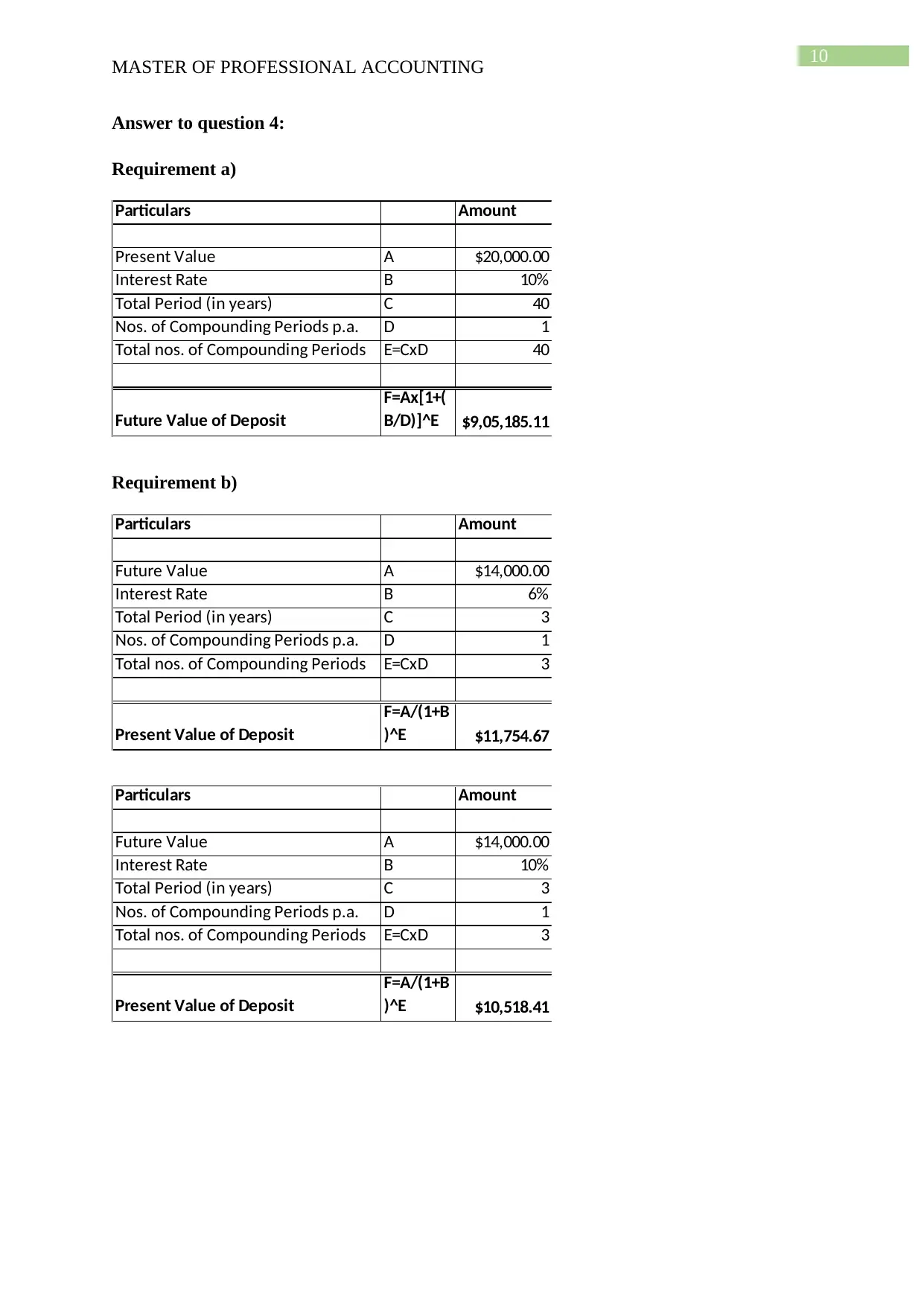
10
MASTER OF PROFESSIONAL ACCOUNTING
Answer to question 4:
Requirement a)
Particulars Amount
Present Value A $20,000.00
Interest Rate B 10%
Total Period (in years) C 40
Nos. of Compounding Periods p.a. D 1
Total nos. of Compounding Periods E=CxD 40
Future Value of Deposit
F=Ax[1+(
B/D)]^E $9,05,185.11
Requirement b)
Particulars Amount
Future Value A $14,000.00
Interest Rate B 6%
Total Period (in years) C 3
Nos. of Compounding Periods p.a. D 1
Total nos. of Compounding Periods E=CxD 3
Present Value of Deposit
F=A/(1+B
)^E $11,754.67
Particulars Amount
Future Value A $14,000.00
Interest Rate B 10%
Total Period (in years) C 3
Nos. of Compounding Periods p.a. D 1
Total nos. of Compounding Periods E=CxD 3
Present Value of Deposit
F=A/(1+B
)^E $10,518.41
MASTER OF PROFESSIONAL ACCOUNTING
Answer to question 4:
Requirement a)
Particulars Amount
Present Value A $20,000.00
Interest Rate B 10%
Total Period (in years) C 40
Nos. of Compounding Periods p.a. D 1
Total nos. of Compounding Periods E=CxD 40
Future Value of Deposit
F=Ax[1+(
B/D)]^E $9,05,185.11
Requirement b)
Particulars Amount
Future Value A $14,000.00
Interest Rate B 6%
Total Period (in years) C 3
Nos. of Compounding Periods p.a. D 1
Total nos. of Compounding Periods E=CxD 3
Present Value of Deposit
F=A/(1+B
)^E $11,754.67
Particulars Amount
Future Value A $14,000.00
Interest Rate B 10%
Total Period (in years) C 3
Nos. of Compounding Periods p.a. D 1
Total nos. of Compounding Periods E=CxD 3
Present Value of Deposit
F=A/(1+B
)^E $10,518.41
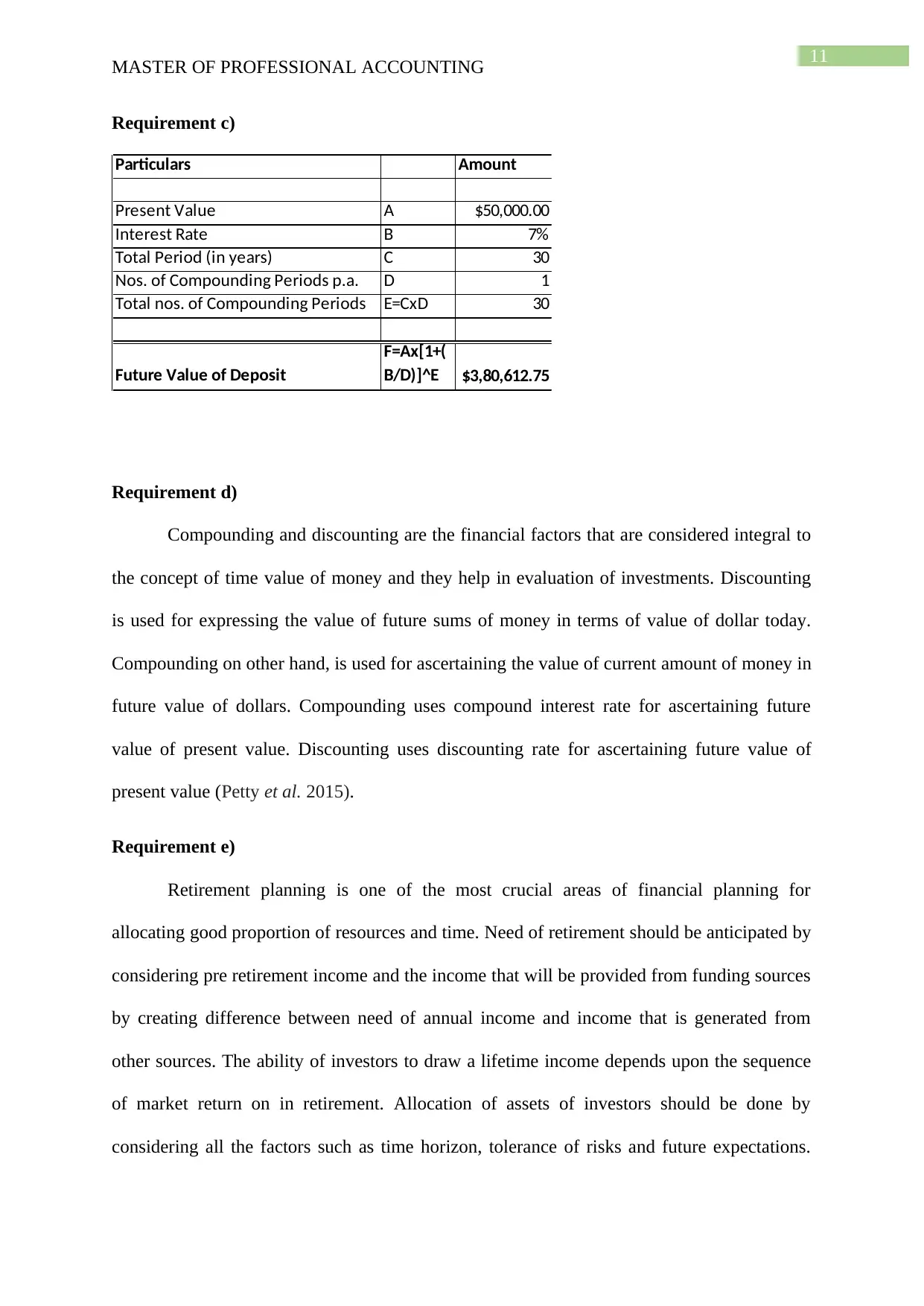
11
MASTER OF PROFESSIONAL ACCOUNTING
Requirement c)
Particulars Amount
Present Value A $50,000.00
Interest Rate B 7%
Total Period (in years) C 30
Nos. of Compounding Periods p.a. D 1
Total nos. of Compounding Periods E=CxD 30
Future Value of Deposit
F=Ax[1+(
B/D)]^E $3,80,612.75
Requirement d)
Compounding and discounting are the financial factors that are considered integral to
the concept of time value of money and they help in evaluation of investments. Discounting
is used for expressing the value of future sums of money in terms of value of dollar today.
Compounding on other hand, is used for ascertaining the value of current amount of money in
future value of dollars. Compounding uses compound interest rate for ascertaining future
value of present value. Discounting uses discounting rate for ascertaining future value of
present value (Petty et al. 2015).
Requirement e)
Retirement planning is one of the most crucial areas of financial planning for
allocating good proportion of resources and time. Need of retirement should be anticipated by
considering pre retirement income and the income that will be provided from funding sources
by creating difference between need of annual income and income that is generated from
other sources. The ability of investors to draw a lifetime income depends upon the sequence
of market return on in retirement. Allocation of assets of investors should be done by
considering all the factors such as time horizon, tolerance of risks and future expectations.
MASTER OF PROFESSIONAL ACCOUNTING
Requirement c)
Particulars Amount
Present Value A $50,000.00
Interest Rate B 7%
Total Period (in years) C 30
Nos. of Compounding Periods p.a. D 1
Total nos. of Compounding Periods E=CxD 30
Future Value of Deposit
F=Ax[1+(
B/D)]^E $3,80,612.75
Requirement d)
Compounding and discounting are the financial factors that are considered integral to
the concept of time value of money and they help in evaluation of investments. Discounting
is used for expressing the value of future sums of money in terms of value of dollar today.
Compounding on other hand, is used for ascertaining the value of current amount of money in
future value of dollars. Compounding uses compound interest rate for ascertaining future
value of present value. Discounting uses discounting rate for ascertaining future value of
present value (Petty et al. 2015).
Requirement e)
Retirement planning is one of the most crucial areas of financial planning for
allocating good proportion of resources and time. Need of retirement should be anticipated by
considering pre retirement income and the income that will be provided from funding sources
by creating difference between need of annual income and income that is generated from
other sources. The ability of investors to draw a lifetime income depends upon the sequence
of market return on in retirement. Allocation of assets of investors should be done by
considering all the factors such as time horizon, tolerance of risks and future expectations.
⊘ This is a preview!⊘
Do you want full access?
Subscribe today to unlock all pages.

Trusted by 1+ million students worldwide
1 out of 18
Related Documents
Your All-in-One AI-Powered Toolkit for Academic Success.
+13062052269
info@desklib.com
Available 24*7 on WhatsApp / Email
![[object Object]](/_next/static/media/star-bottom.7253800d.svg)
Unlock your academic potential
Copyright © 2020–2025 A2Z Services. All Rights Reserved. Developed and managed by ZUCOL.





